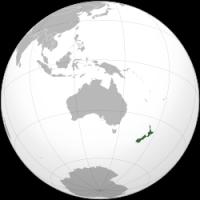|
|
|
Polynesians settled New Zealand in 1250 � 1300 AD and developed a distinctive Māori culture, and Europeans first made contact in 1642 AD. The introduction of potatoes and muskets triggered upheaval among Māori early during the 19th century, which led to the inter-tribal Musket Wars. In 1840 the British and Māori signed a treaty making New Zealand a colony of the British Empire. Immigrant numbers increased sharply and conflicts escalated into the New Zealand Wars, which resulted in much Māori land being confiscated in the mid North Island. Economic depressions were followed by periods of political reform, with women gaining the vote during the 1890s, and a welfare state being established from the 1930s. After World War II, New Zealand joined Australia and the United States in the ANZUS security treaty, although the United States later suspended the treaty after New Zealand banned nuclear weapons. New Zealanders enjoyed one of the highest standards of living in the world in the 1950s, but the 1970s saw a deep recession, worsened by oil shocks and the United Kingdom's entry into the European Economic Community. The country underwent major economic changes during the 1980s, which transformed it from a protectionist to a liberalised free-trade economy. Markets for New Zealand's agricultural exports have diversified greatly since the 1970s, with once-dominant exports of wool being overtaken by dairy products, meat, and recently wine. The majority of New Zealand's population is of European descent; the indigenous Māori are the largest minority, followed by Asians and non-Māori Polynesians. English, Māori and New Zealand Sign Language are the official languages, with English predominant. Much of New Zealand's culture is derived from Māori and early British settlers. Early European art was dominated by landscapes and to a lesser extent portraits of Māori. A recent resurgence of Māori culture has seen their traditional arts of carving, weaving and tattooing become more mainstream. Many artists now combine Māori and Western techniques to create unique art forms. The country's culture has also been broadened by globalisation and increased immigration from the Pacific Islands and Asia. New Zealand's diverse landscape provides many opportunities for outdoor pursuits and has provided the backdrop for a number of big budget movies. New Zealand is organised into 11 regional councils and 67 territorial authorities for local government purposes; these have less autonomy than the country's long defunct provinces did. Nationally, executive political power is exercised by the Cabinet, led by the Prime Minister. Queen Elizabeth II is the country's head of state and is represented by a Governor-General. The Queen's Realm of New Zealand also includes Tokelau (a dependent territory); the Cook Islands and Niue (self-governing but in free association); and the Ross Dependency, New Zealand's territorial claim in Antarctica. New Zealand is a member of the Asia-Pacific Economic Cooperation, Commonwealth of Nations, Organisation for Economic Co-operation and Development, Pacific Islands Forum, and the United Nations. |




 RSS
RSS